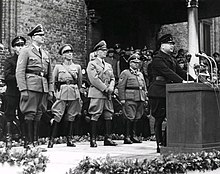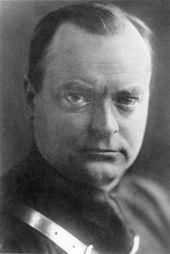Anton Mussert
Anton Adriaan Mussert (born May 11, 1894 in Werkendam ; † May 7, 1946 in The Hague ) was a Dutch civil engineer and politician. He was co-founder and chairman of the Dutch National Socialist NSB . The German National Socialists gave him the non-functional honorary title of “Leader of the Dutch People” during World War II . After the war, Mussert was sentenced to death in a high treason trial and executed .
Life
Mussert grew up as the son of the school teacher Joannes Leonardus Mussert and his wife Frederika Witlam in the Dutch province of Brabant . After attending school in Gorinchem , he studied at the Technical University in Delft . In 1918 he completed his studies in road and hydraulic engineering with an engineering examination.
On September 19, 1917, he married his aunt Maria Witlam, who was 18 years his senior. The marriage remained childless.
His first job was with the Dutch Supreme Road and Water Authority ( Rijkswaterstaat ), then he found a job with the water authority in the province of Utrecht , where he made a steep career and was a senior engineer from 1927.
Political rise
From the 1920s he was active in various right-wing extremist organizations such as Dietsche Bond , which called for Flanders to join the Greater Netherlands . Together with Cornelis van Geelkerken and ten other people, Mussert founded the NSDAP- oriented National Socialist Movement of the Netherlands (NSB) on December 14, 1931 with him as chairman. A black uniformed " Weerbaarheidsafdeling " was set up as a counterpart to the SA .
Mussert gave up his civil engineering career in order to devote himself entirely to political activity. He quickly became the most prominent National Socialist in the Netherlands and met Adolf Hitler for the first time in November 1936; three more meetings were to follow. Even Pope Pius XI. received him on June 16, 1936. The NSB grew to over 50,000 members and received almost 8 percent of the votes nationwide in the provincial elections in the mid-1930s. It had become a political factor to be taken seriously. In 1937, however, the party had already lost many sympathizers and only achieved 4 percent in the parliamentary elections. The political proximity of the party to the “ Third Reich ” was too unpopular in Dutch society, which was emphatically affirmed by the state, the established parties and the churches. Dutch officials were banned from joining the NSB as early as 1934; a year later the “Weerbaarheidsafdeling” was banned and dissolved again.
During the war

After the German invasion of the Netherlands in May 1940, Mussert and his party regained importance. He welcomed the fascist “new order in Europe” under German leadership and hoped to become regent or Dutch prime minister along the lines of the Norwegian Vidkun Quisling , but only received the non-functional honorary title of “Leader of the Dutch people”. In 1941 Mussert founded the SS Volunteer Legion Netherlands , which took part in the war against the Soviet Union wearing German uniforms .
On February 1, 1943, a cabinet was set up under his leadership (and under Reichskommissar Arthur Seyss-Inquart ).
After the end of the war
On May 7, 1945, he was arrested in November for collaboration brought to justice and because of treason to death by firing squad condemned. In a clemency renounced Mussert. His family provided it for him, but the queen turned it down in early May. On May 7, 1946, Mussert was executed on Waalsdorpervlakte north of The Hague .
After his execution, Mussert was buried in a mass grave in a cemetery in The Hague, which was not marked and only known to close relatives. Nevertheless, in June 1956 there was a grave robbery with media coverage, in which one of the corpses in the grave was exhumed and kidnapped by strangers. However, it is considered unlikely that the missing bones were actually the Musserts.
literature
- Werner Loh, Wolfgang Wippermann , Lothar Fritze : "Fascism" is controversial. Lucius & Lucius, 2003, ISBN 3-8282-0238-1 .
- Christoph Strupp : The despised leader: Anton Adriaan Mussert and the unpopular rights in Dutch historiography. In: Georg Christoph Berger Waldenegg, Francisca Loetz, Ed .: Leader of the extreme right. Chronos 2006, pp. 161-180.
- Konrad Kwiet : On the history of the Mussert movement. Quarterly issues for contemporary history, 1970 issue 2, (PDF).
Web links
- Literature by and about Anton Mussert in the catalog of the German National Library
- Wolf Oschlies : Biography on Shoa.de (German)
- Ir. AA (Anton) Mussert , Parlement & Politiek
- MUSSERT, Anton Adriaan (1894–1946) , Instituut voor Nederlandse Geschiedenis
- Newspaper article about Anton Mussert in the 20th century press kit of the ZBW - Leibniz Information Center for Economics .
Individual evidence
- ↑ Yuri Visser: De executie van Anton Mussert (7 mei 1946). In: historiek.net. Retrieved April 9, 2019 (Dutch).
- ^ René ten Dam: Het verdwenen count van Anton Mussert. In: dodenakkers.nl. July 9, 2008, accessed April 9, 2019 (Dutch).
| personal data | |
|---|---|
| SURNAME | Mussert, Anton |
| ALTERNATIVE NAMES | Mussert, Anton Adriaan (full name) |
| BRIEF DESCRIPTION | Dutch civil engineer, National Socialist politician (NSB, chairman) and founder of the SS Volunteer Legion Netherlands |
| DATE OF BIRTH | May 11, 1894 |
| PLACE OF BIRTH | Werkendam , Netherlands |
| DATE OF DEATH | May 7, 1946 |
| Place of death | The hague |

